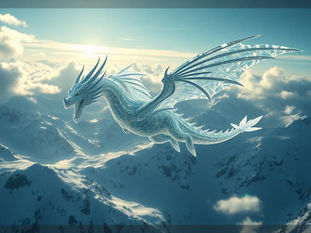
Simple Steps to Start Making Comics with Midjourney
May 17
4 min read
0
42
0

Making comics usually requires strong drawing skills. For many, this is a big challenge. AI tools like Midjourney offer a new way to create visual stories. If you've thought about creating your own comic book but don't draw, Midjourney might help.
Using AI for comics is still new. It has challenges, but you can get useful results for shorter projects. One creator recently used Midjourney to make two short comic books, proving it's possible to start building a visual story.
Setting Up Your Midjourney Comic Style
Getting started means deciding on a look for your comic. You need consistency across your images. Here are some key steps:
Get Style Ideas from Artists
Think about comic book artists whose style you like. You can use the name of a famous artist in your prompts. Adding "comic" and an artist's name, like "Scott Snider," to every prompt helps Midjourney give you images with a similar feel. This is a big help for keeping your visuals consistent from panel to panel.
Pick Your Colors and Setting
Use specific colors in your prompts, like "black and red colors" or "green and black." This gives your comic a defined color palette. Also, pick a general environment or mood keyword, such as "Streets of New York" or "rainy day." Adding this to your prompts helps keep the background elements and overall atmosphere consistent.
Choose an Aspect Ratio
Stick to one or two aspect ratios for your images. Using a consistent ratio like 16:9 or 1:1 helps maintain a similar look and feel throughout your comic panels.
Creating and Using Characters
Your characters need to look like themselves in different scenes. Midjourney offers a way to do this.
Design Your Main Hero or Villain
Start by generating images for your main character using your style prompts. You might need to run the prompt multiple times. Once you get a design you like, upscale it.
Use Character Reference
Download the upscaled character image and upload it back into Midjourney. When you prompt for a scene with this character, use the image as a character reference. You do this by clicking the image and selecting the person icon setting. Adding this reference image to your prompt tells Midjourney to try and make the character look like the one in your reference photo. Using two different reference images of the same character (like one face shot and one full body shot) can sometimes improve consistency.
Prompting Scenes
Now, combine your character reference with prompts for the scene. Include the environment, time of day, or weather keywords you chose earlier. For example, use your character reference image and the prompt "superhero on a skyscraper roof, New York, rainy day, comic, Scott Snider, black and red colors."
While using character references is great for consistency, Midjourney sometimes mixes the reference with other prompt details. You might need to adjust and rerun prompts to get the scene you want.
Challenges When Making Comics with Midjourney
AI tools are still developing, and making a full comic reveals some weak spots.
Trouble with Environment Consistency
Even with environment keywords, keeping backgrounds exactly the same can be hard. If a scene is supposed to be in the exact same office, images might show small differences in furniture or windows. The same happens with specific objects like a car – it might look slightly different in different panels.
Getting Multiple Characters Right
Creating images with your main characters interacting with each other is one of the toughest things to do. If you use character references for two main characters in the same prompt, Midjourney can get confused and blend the designs. It's often easier to generate scenes with only one main character or with generic non-player characters (NPCs) like "a group of cops" or "people in the streets." For scenes needing two main characters interacting, you might just have to rely on dialogue and panel layout rather than getting a perfect AI image of them together.
Generating Action Scenes Is Limited
Midjourney's rules often make it hard to generate images with intense action, fighting, or violence. Many comic stories involve conflict, so trying to prompt explosions or fight scenes can be difficult or restricted. You might need to find creative workarounds or simplify how you show these moments.
Inpainting Isn't Always Reliable
Trying to fix small details or add things to an image using inpainting features sometimes doesn't work as expected, especially when character references are involved. Rerunning prompts until you get a better result might be more reliable than trying to edit via inpainting.
Adding Text
Midjourney is not good at adding text, like speech bubbles or captions. You will need to use an external editing program, like Photoshop, to add all the dialogue and sound effects to your comic panels.
Tips for Success
Based on these experiences, here are key things to focus on:
Pick a comic artist style you like and use their name in prompts.
Define a color palette and environmentkeyword at the start.
Use character references for your main hero and villain.
It's often easier to generate panels with only one primary character.
Keep your prompts for the scene (what the character is doing) relatively short and clear so the style keywords (artist, color, environment) aren't ignored.
Be ready to rerun prompts many times to get the images you need.
You will need another tool to add text to your images.
Streamline Your Midjourney Workflow
Creating a comic involves generating many variations and keeping track of prompts, especially when dealing with character consistency. Managing all these images and prompting needs can be time-consuming. Consider using a tool designed to help automate and manage your Midjourney creations.
The TitanXT Midjourney Automation Suite can help simplify repetitive tasks and manage your image generation process. Learn how the TitanXT Midjourney Automator can assist your comic creation process.
Final Thoughts
Making a full-length graphic novel with AI is still a big project. While current tools have limits, especially with detailed consistency and complex multi-character scenes, making shorter comic stories is definitely possible. As AI improves, it will hopefully become easier to create longer, more detailed visual narratives.
Experiment with different prompts, settings, and workflows. Tools are always getting better. Maybe the future will see AI perfect the art of collaborative storytelling.
If you're spending a lot of time managing your Midjourney generations, exploring automation tools like the TitanXT Midjourney Automation Suite could free up time to focus on the story itself.






